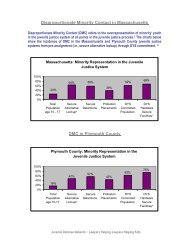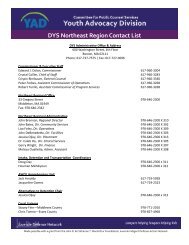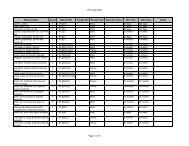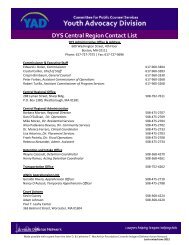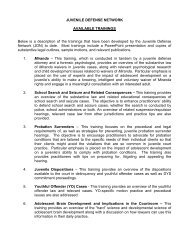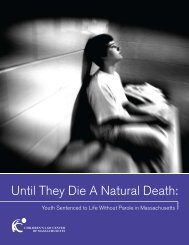States rethink 'adult time for adult crime' - the Youth Advocacy Division
States rethink 'adult time for adult crime' - the Youth Advocacy Division
States rethink 'adult time for adult crime' - the Youth Advocacy Division
You also want an ePaper? Increase the reach of your titles
YUMPU automatically turns print PDFs into web optimized ePapers that Google loves.
What Makes Teens Tick; A flood of hormones, sure. But also a host of struct...plain <strong>the</strong> behaviors that make adolescence so exciting--and so exasperating<br />
life's work is nothing more than an attempt to establish a gigantic control group. "It<br />
turned out that normal brains were so interesting in <strong>the</strong>mselves," he marvels. "And<br />
<strong>the</strong> adolescent studies have been <strong>the</strong> most surprising of all."<br />
Be<strong>for</strong>e <strong>the</strong> imaging studies by Giedd and his collaborators at UCLA, Harvard, <strong>the</strong><br />
Montreal Neurological Institute and a dozen o<strong>the</strong>r institutions, most scientists<br />
believed <strong>the</strong> brain was largely a finished product by <strong>the</strong> <strong>time</strong> a child reached <strong>the</strong> age<br />
of 12. Not only is it full-grown in size, Giedd explains, but "in a lot of psychological<br />
literature, traced back to [Swiss psychologist Jean] Piaget, <strong>the</strong> highest rung in <strong>the</strong><br />
ladder of cognitive development was about age 12--<strong>for</strong>mal operations." In <strong>the</strong> past,<br />
children entered initiation rites and started learning trades at about <strong>the</strong> onset of<br />
puberty. Some <strong>the</strong>orists concluded from this that <strong>the</strong> idea of adolescence was an<br />
artificial construct, a phenomenon invented in <strong>the</strong> post--Industrial Revolution years.<br />
Giedd's scanning studies proved what every parent of a teenager knows: not only is<br />
<strong>the</strong> brain of <strong>the</strong> adolescent far from mature, but both gray and white matter undergo<br />
extensive structural changes well past puberty. "When we started," says Giedd, "we<br />
thought we'd follow kids until about 18 or 20. If we had to pick a number now, we'd<br />
probably go to age 25."<br />
Now that MRI studies have cracked open a window on <strong>the</strong> developing brain,<br />
researchers are looking at how <strong>the</strong> newly detected physiological changes might<br />
account <strong>for</strong> <strong>the</strong> adolescent behaviors so familiar to parents: emotional outbursts,<br />
reckless risk taking and rule breaking, and <strong>the</strong> impassioned pursuit of sex, drugs and<br />
rock 'n' roll. Some experts believe <strong>the</strong> structural changes seen at adolescence may<br />
explain <strong>the</strong> timing of such major mental illnesses as schizophrenia and bipolar<br />
disorder. These diseases typically begin in adolescence and contribute to <strong>the</strong> high<br />
rate of teen suicide. Increasingly, <strong>the</strong> wild conduct once blamed on "raging<br />
hormones" is being seen as <strong>the</strong> by-product of two factors: a surfeit of hormones,<br />
yes, but also a paucity of <strong>the</strong> cognitive controls needed <strong>for</strong> mature behavior.<br />
In recent years, Giedd has shifted his focus to twins, which is why <strong>the</strong> Manns are<br />
such exciting recruits. Although most brain development seems to follow a set plan,<br />
with changes following cues that are preprogrammed into genes, o<strong>the</strong>r, subtler<br />
changes in gray matter reflect experience and environment. By following twins, who<br />
start out with identical--or, in fraternal twins, similar--programming but <strong>the</strong>n diverge<br />
as life takes <strong>the</strong>m on different paths, he hopes to tease apart <strong>the</strong> influences of<br />
nature and nurture. Ultimately, he hopes to find, <strong>for</strong> instance, that Anthony Mann's<br />
plan to become a pilot and Brandon's to study law will lead to brain differences that<br />
are detectable on future MRIs. The brain, more than any o<strong>the</strong>r organ, is where<br />
experience becomes flesh.<br />
Throughout <strong>the</strong> afternoon, <strong>the</strong> Mann bro<strong>the</strong>rs take turns completing tests of<br />
intelligence and cognitive function. Between sessions <strong>the</strong>y occasionally needle one<br />
ano<strong>the</strong>r in <strong>the</strong> waiting room. "If <strong>the</strong> o<strong>the</strong>r person is in a bad mood, you've got to<br />
provoke it," Anthony asserts slyly. Their mo<strong>the</strong>r Nancy Mann, a sunny paragon of<br />
patience who has three daughters in addition to <strong>the</strong> five boys, smiles and rolls her<br />
eyes.<br />
Shortly be<strong>for</strong>e 5 p.m., <strong>the</strong> Manns head downstairs to <strong>the</strong> imaging floor to meet <strong>the</strong><br />
magnet. Giedd, a trim, energetic man with a reddish beard, twinkly blue eyes and an<br />
impish sense of humor, greets Anthony and tells him what to expect. He asks<br />
Anthony to remove his watch, his necklace and a high school ring, labeled KEEPER.<br />
Does Anthony have any metal in his body Any piercings Not this clean-cut, soccerplaying<br />
Mormon. Giedd tapes a vitamin E capsule onto Anthony's left cheek and one<br />
in each ear. He explains that <strong>the</strong> oil-filled capsules are opaque to <strong>the</strong> scanner and<br />
will define a plane on <strong>the</strong> images, as well as help researchers tell left from right. The<br />
scanning will take about 15 minutes, during which Anthony must lie completely still.<br />
Dressed in a red sweat shirt, jeans and white K-Swiss sneakers, he stretches out on<br />
<strong>the</strong> examining table and slides his head into <strong>the</strong> machine's giant magnetic ring.<br />
MRI, Giedd points out, "made studying healthy kids possible" because <strong>the</strong>re's no<br />
radiation involved. (Be<strong>for</strong>e MRI, brain development was studied mostly by using<br />
file:///L|/JDN/Brain%20Resources/Brain%20Developmen...iling%20Packet/8.%20What%20Makes%20Teens%20Tick.htm (2 of 8)8/16/2006 4:44:18 PM





